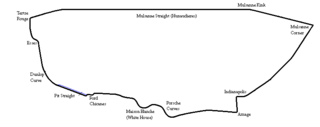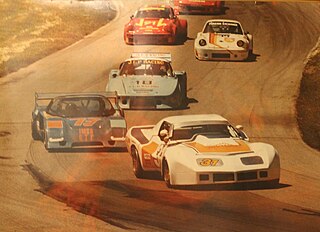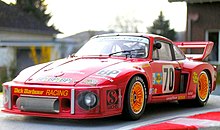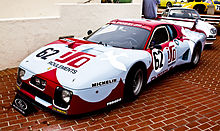
The 24 Hours of Daytona, also known as the Rolex 24 At Daytona for sponsorship reasons, is a 24-hour sports car endurance race held annually at Daytona International Speedway in Daytona Beach, Florida. It is run on the Sports Car Course layout, a 3.56-mile (5.73 km) combined road course that uses most of the tri-oval plus an infield road course. Held on the last weekend of January or first weekend of February as part of Speedweeks, it is the first major automobile race of the year in North America. The race is sanctioned by IMSA and is the first race of the season for the IMSA SportsCar Championship.

The Porsche 935 is a race car that was developed and manufactured by German automaker Porsche. Introduced in 1976 as the factory racing version of the 911 (930) Turbo and prepared for FIA-Group 5 rules, it was an evolution of the Carrera RSR 2.1 turbo prototype, the second place overall finisher in the 1974 24 Hours of Le Mans.
The International Motor Sports Association (IMSA) is a North American sports car racing sanctioning body based in Daytona Beach, Florida under the jurisdiction of the ACCUS arm of the FIA. It was started by John Bishop, a former executive director of SCCA, and his wife Peggy in 1969 with help from Bill France Sr. of NASCAR. Beginning in 2014, IMSA is the sanctioning body of the WeatherTech SportsCar Championship, the premier series resulting from the merger of Grand-Am Road Racing and the American Le Mans Series. IMSA is owned by NASCAR, as a division of the company.

A Daytona Prototype was a type of sports prototype racing car developed specifically for the Grand American Road Racing Association's Rolex Sports Car Series as their top class of car, which replaced their main prototype racing class, specifically Le Mans Prototypes (LMPs). The cars later competed in the merged series of the IMSA SportsCar Championship, from 2014 to 2016, before being phased out and replaced by the Daytona Prototype International class in 2017. They are named after the main series event, the Rolex 24 at Daytona.

The 1982 24 Hours of Le Mans was the 50th Grand Prix of Endurance, which took place on 19 and 20 June 1982. It was also the fourth round of the 1982 World Endurance Championship. As well as a significant anniversary, this was a watershed year for Le Mans, with the highly anticipated advent of the FIA's Group C regulations, the essence of which was to allow an open engine formula but a minimum weight for safety and a proscribed fuel allocation.

The 1981 24 Hours of Le Mans was the 49th Grand Prix of Endurance, and took place on 13 and 14 June 1981. It was also the eighth round of the World Endurance Championship of Drivers, and the fifth round of the World Championship for Makes.

The 1980 24 Hours of Le Mans was the 48th Grand Prix of Endurance, and took place on 14 and 15 June 1980. It was the seventh round of both the World Championship for Makes and World Challenge for Endurance Drivers. With neither the Porsche nor Renault works teams contesting the big Group 6 sports-cars for outright victory, it left the prospects open for a privateer victory from Joest, Rondeau or De Cadenet, or from Group 5 again, if they were to fail. The wet weather throughout the race further added to the uncertainty, reducing the advantage of the more powerful cars.

The 1978 24 Hours of Le Mans was the 46th Grand Prix of Endurance, and took place on 10 and 11 June 1978. In many ways it was a continuation of the race from the year before – the two main protagonists would be the very evenly-matched works teams of Alpine-Renault and Porsche, with four cars each. The race was not valid for any championship.

The 1977 24 Hours of Le Mans was the 45th Grand Prix of Endurance, and took place on 11 and 12 June 1977. The second year of the FIA Group 5 and Group 6 regulations, it produced an exciting race right up to the end. Porsche had withdrawn from the Group 6 Championship, citing a lack of broad competition. Renault, before their move into Formula 1, decided to put its main racing focus for the year onto Le Mans. The two works teams were the pre-race favourites.

The 1976 24 Hours of Le Mans was the 44th Grand Prix of Endurance, and took place on 12 and 13 June 1976. This year the FIA introduced its new Group 5 and Group 6 regulations and the race was now open to nine distinct classes, although it was still not part of the World Championship seasons. Porsche introduced its new models, the 936 in Group 6, the 935 in Group 5 and the 934 in Group 4. In response, BMW had its modified 3.0 CSL in Group 5. It was the year that turbos arrived in considerable numbers, with over a dozen turbocharged entries, led by the Renault Alpine A442. It saw the arrival of French prototype manufacturers Jean Rondeau and Gérard Welter in a new GTP class and a first-time invitation to American IMSA and NASCAR entries.
Group 5 was an FIA motor racing classification which was applied to four distinct categories during the years 1966 to 1982. Initially Group 5 regulations defined a Special Touring Car category and from 1970 to 1971 the classification was applied to limited production Sports Cars restricted to 5 litre engine capacity. The Group 5 Sports Car category was redefined in 1972 to exclude the minimum production requirement and limit engine capacity to 3 litres. From 1976 to 1982 Group 5 was for Special Production Cars, a liberal silhouette formula based on homologated production vehicles.

IMSA GT was a sports car racing series organized by International Motor Sports Association. Races took place primarily in the United States and occasionally in Canada.

Grand Touring Prototype (GTP) is the name of a former classification designated to sports prototypes in sports car racing competing in the IMSA GT Championship, maintained by IMSA between 1981 and 1993. The early cars were based on the almost same identical ruleset as the FIA's Group C category, but eventually evolved into a separate category. It was the successor to the Grand Touring Experimental (GTX) class, which were based on FIA Group 5 and Group 6 cars.

Grand Touring Over (GTO) is the name of a former classification designated to grand touring cars competing in sports car racing, originally by IMSA in the IMSA GT Championship, and later by Grand-Am in the Rolex Sports Car Series. IMSA used the class between 1971 and 1991, and Grand-Am used the class for a single season in 2000. The class had its origins in the original "TO" class used by the SCCA in the Trans-Am series, and was also similarly modeled to the FIA's Group 4 and Group 5 racing classes, but eventually evolved over time into its own category. The class specified an engine displacement of more than 2.5 L (150 cu in), with engine design and number of cylinders being unrestricted. turbocharging and supercharging was allowed on engines up to a size of 6.0 L (370 cu in). Engines over 6.0 L (370 cu in) were required to be naturally aspirated. The original class became known as Grand Touring Supreme (GTS) in 1992.

The Australian GT Championship is a CAMS-sanctioned national title for drivers of GT cars, held annually from 1960 to 1963, from 1982 to 1985 and from 2005. Each championship up to and including the 1963 title was contested over a single race and those after that year over a series of races. The categories which have contested the championship have not always been well defined and often have become a home for cars orphaned by category collapse or a sudden change in regulation.

The 1984 Sandown 1000 was an endurance motor race staged at the Sandown Raceway in Victoria, Australia on 2 December 1984. It was the eleventh and final round of the 1984 FIA World Endurance Championship and was the first FIA World Championship race to be held in Australia. It was to be the first of a three-year contract to race at Sandown, though the final two years would be cancelled.

The Lola T600 was a racing car introduced in 1981 by Lola Cars as a customer chassis. It was the first GT prototype race car to incorporate ground-effect tunnels for downforce. The revolutionary aerodynamic design of the T600 was widely imitated throughout the 1980s by International Motor Sports Association (IMSA) and Group C prototype cars. The Lola T600 ran initially in the U.S.-based IMSA GT series and later in European Group C races.
The Sportscar Vintage Racing Association (SVRA) is an American automobile club and sanctioning body that supports vintage racing in the United States. The organization was founded in 1981, and is regarded as the premier vintage racing organization in the U.S.
The Lola T616 is a sports prototype built by Lola Cars to the Group C2 and IMSA GTP regulations. It was built with the intention to compete in the IMSA GT Championship and the World Sportscar Championship, and became the second Mazda-powered prototype to score a class win at the 24 Hours of Le Mans after the 717C triumphed in the same C2 class at the 1983 24 Hours of Le Mans.
All American Grand Touring (AAGT) is the name of a former classification and set of regulations designated to grand touring cars in sports car racing, competing in the IMSA GT Championship, maintained by IMSA between 1975 and 1989. These cars were All-American, V8-powered, used a maximum of 5 forward gears, and used a steel tube frame (similar to the type used in the SCCA Trans-Am Series), and were designed to compete against heavyweight European manufacturers and machinery of the time, such as Porsche and BMW, who were dominating the series at the time.














